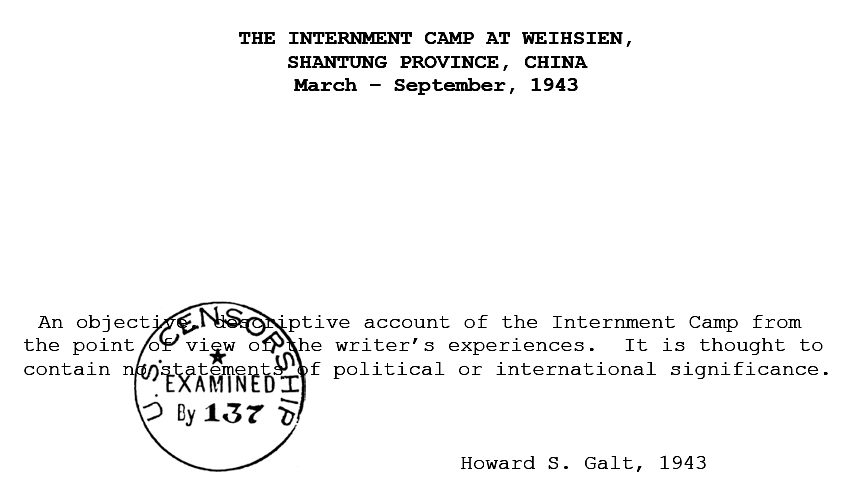
- by Howard S. Galt
 [excerpts]
[excerpts]
Upon arrival we first lined up on the small athletic field, near the church, for a thorough check-up, roll-call and then were marched to “Building No. 24” for assignments of temporary quarters for the night. Men were placed in the basement classrooms and women in the classrooms above. There were no furnishings in these classrooms except a few reed-mats for the floor – not enough for all. There were, however, two or three stoves placed where their heat could temper somewhat the cold rooms.
[excerpt]
From the beginning of camp life the Japanese insisted on a daily roll-call, or check-up on members. The hour for this was at first 10:00 o’clock, but this time, in the midst if the dinner work period proved very inconvenient.
Consequently the roll-call was changed to 7:30 in the morning. Consular police or guards made the rounds of buildings and rooms, which had been grouped in numbered blocks, and called for the prompt appearance of all residents outside their doors to be counted. It soon became apparent that in each block there was a need for someone to call people to their doors (considering the early morning hour) at the right moment, to save the time of all concerned. For this service, and also to serve as convenient means of communication in verbal notices or orders, wardens were appointed for the several blocks. (The clever reader, like the facetious persons in camp, perhaps cannot resist the temptation to call these functionaries “block-heads”-but this term never became popular!) The total number of these numbered blocks was about 60 and such approximately was the number of wardens, comprising both men and women.
[...]
The daily roll-call, in which the wardens officiated, occasionally exhibited features both interesting and amusing. Late sleepers were often reluctant to appear outside their doors, the men frequently being seen in their pajamas, or with faces covered with lather for the shaving process.
On the part of the police, as time went on the roll-call became more and more perfunctory.
Frequently they passed the blocks rapidly, accepting the wardens’ reports that all were present or accounted for (quite a number of persons were already at work in the kitchen or elsewhere at the roll-call hour) and scarcely looking at the line of people standing in the doors. Occasionally the roll-call was carried out in a comprehensive and careful way. The whole camp personnel was assembled on the athletic field by the church, and lined up in numerical order according to the number which at the outset had been assigned to all. The consular police carefully checked each line, then added and compared results as a check on total attendance.
Nearly an hour of standing in line was involved on each of these occasions, which occurred about once a month.
[further reading]
http://www.weihsien-paintings.org/DonMenzi/ScrapBook/1943-Galt_Weihsien-1.pdf
#








